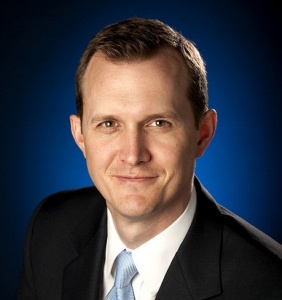Breaking Travel News Interview: George Whitesides, president, Virgin Galactic

Last month, the developer of Virgin Galactic’s SpaceShipTwo suborbital space tourism vehicle was granted U.S. regulatory approval to begin rocket-powered flight testing, bringing space travel a step closer to becoming a reality. Breaking Travel News catches up with George Whitesides, president and chief executive of Virgin Galactic to find out what this means for space tourism.
Breaking Travel News: What does SpaceShipTwo’s clearance by the FAA mean for Virgin Galactic? When will flight tests commence?
George Whitesides This important milestone enables our team to progress to the rocket-powered phase of test flight, bringing us a major step closer to bringing our customers to space. With this permit now in hand, Scaled is now authorized to press onward toward rocket powered test flights.
In preparation for those powered flights, SpaceShipTwo will soon return to flight testing. The aerodynamic performance of the spacecraft with the full weight of the rocket motor system on board.
Integration of key rocket motor components, already begun during a now-concluding period of downtime for routine maintenance, will continue into the autumn.
Scaled expects to begin rocket powered, supersonic flights under the just-issued experimental permit toward the end of the year. We plan to make the first powered flight of SpaceShipTwo by the end of 2012.
BTN: Are you any closer to being able confirm a date for the first Virgin Galactic passenger flight?
GW: We continue to make excellent progress in the test flight program of our commercial vehicles. Depending primarily on how the remaining test flight programme goes, we plan to begin commercial operations in 2013.
BTN: How many passengers have signed up for VG flights? Who can travel with VG What is the cost of a trip?
GW: Ticket prices are set at $200,000 each. We’ve been very pleased to see that so many people have signed up already—having more than 500 customers is a great validation of what we are doing and the price we are charging. Safety is of paramount importance for Virgin Galactic’s spaceflight program. Based on our initial evaluations and training, we expect that most people with at least average health should be able to fly with us. We want our customers to have the experience of a lifetime safely and enjoyably.
BTN: Where will the initial flights take place from?
GW: Initial commercial flights will take place from Spaceport America in southern New Mexico. Test flights, which are ongoing now, are flown from Mojave Air and SpacePort in California.
BTN: What should VG passengers expect from their travel experience?
Flight time will be approximately two hours from takeoff to landing. At 50,000 feet, WhiteKnightTwo will release SpaceShipTwo for a thrilling rocket ride away from the earth’s surface. Once in space, SS2 passengers will have several minutes of out-of seat weightlessness before returning to Earth.
BTN: Can you describe the interior of the WhiteKnightTwo and SpaceShipTwo?
GW: We have not released thefinal design of the interior, but you can see our website for some details on SpaceShipTwo’s interior.
BTN: What are the main objectives for Spaceport Abu Dhabi?
GW: Under a deal announced in 2009 between Virgin Galactic and aabar Investments, the two companies agreed that Abu Dhabi would gain exclusive regional rights, subject to the receipt of regulatory clearances, to host Virgin Galactic tourism and scientific research space flights.
BTN: What will this development mean for the emirate?
GW: If the spaceport gains regulatory approval and all financial requirements, we anticipate the Spaceport in Abu Dhabi will become a regional hub for space tourism, as well as space-based science research and education.
BTN: How closely will you be working with recently appointed Steve Landeene?
GW: We will work closely with him. He is responsible for developing a roadmap for the proposed construction of a spaceport in Abu Dhabi. Starting from strategic and organisational business planning, and then, if the requisite regulatory approvals are obtained, moving through to spaceport construction management and finally to spaceport operations, Landeene will ensure that Spaceport Abu Dhabi meets the objectives of its investors and complies with all applicable laws and regulations.
BTN: Which other destinations are you considering expanding to?
GW: Our first priority is get operations started at Spaceport America and make a success of that.
BTN: In what ways are you supporting communities in which you are involved?
GW: Our goal is to enhance local economies where we have a presence through jobs, local tourism and hospitality spending. We also support educational opportunities through our organization Galactic Unite.
BTN: What are the main challenges that you are facing?
GW: We are at an advanced stage in our flight test program, and so far it’s going very well. We do encounter challenges along the way, but continually learn and adapt as we go. The very nature of flight test allows you to perform and perfect your capabilities. Our next major milestone will be the commencement of powered test flights expected later this year.
BTN: What does the future look like in terms of space travel?
GW: All the research we and others have done suggest that with the right product, this market is huge. Our anecdotal experience and our pre-delivery order book supports that. It’s a question of experience, cost, supply and safety. We are extremely pleased with our sales so far. With every milestone, our rate of sales increases.
BTN: Will Virgin Galactic bring space travel to the masses?
GW: We anticipate that our success will mean that space travel will become increasingly affordable. We expect to fly thousands of people in the first ten years of operation.
BTN: What would be the implications of this?
GW: In much the same way that the early users of commercial aviation services enabled the commercial airline industry, our early adopters will open up the space experience to a much wider group of people.

